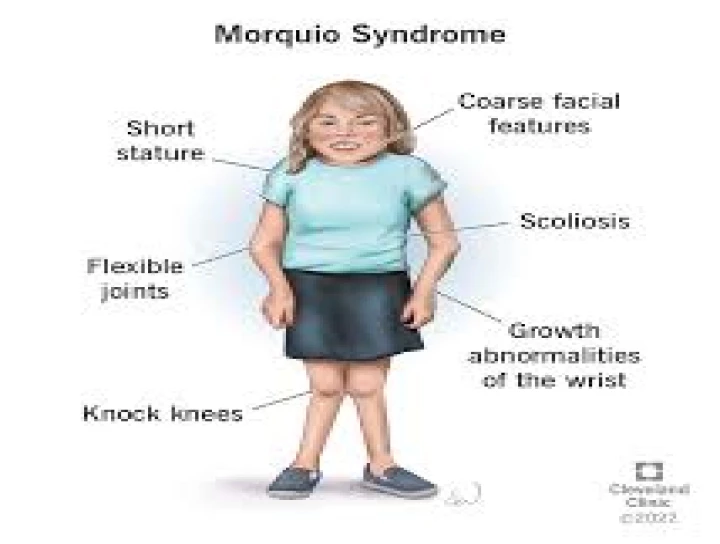
**Morquio Syndrome** (also known as **Mucopolysaccharidosis IV, MPS IV**) is a rare genetic disorder characterized by a deficiency in specific enzymes that leads to the accumulation of glycosaminoglycans (GAGs) in various tissues throughout the body. This accumulation results in a range of skeletal, dental, and systemic abnormalities. Morquio Syndrome is classified into two types based on the specific enzyme deficiency:
### Types of Morquio Syndrome
**1. **Morquio Syndrome Type A:**
- **Enzyme Deficiency:** Deficiency of the enzyme **N-acetylgalactosamine-6-sulfatase** (GALNS).
- **Inheritance Pattern:** Autosomal recessive.
**2. **Morquio Syndrome Type B:**
- **Enzyme Deficiency:** Deficiency of the enzyme **beta-galactosidase** (GLB1).
- **Inheritance Pattern:** Autosomal recessive.
### Clinical Features
**1. **Skeletal Abnormalities:**
- **Short Stature:** Patients typically exhibit short stature due to abnormal growth and skeletal dysplasia.
- **Skeletal Dysplasia:** Includes abnormalities such as kyphosis (curvature of the spine), scoliosis (sideways curvature of the spine), and hip dysplasia.
- **Joint Issues:** Progressive joint stiffness and limited range of motion are common, often leading to early arthritis.
**2. **Dental Anomalies:**
- **Delayed Eruption:** Teeth may erupt later than normal.
- **Malocclusion:** Dental misalignment and crowding may occur due to skeletal changes.
- **Enamel Defects:** Enamel hypoplasia, leading to increased susceptibility to dental caries.
**3. **Other Systemic Features:**
- **Respiratory Issues:** Patients may experience respiratory problems due to upper airway obstruction and reduced lung capacity.
- **Cardiac Problems:** Some individuals may have cardiovascular issues, including valve abnormalities.
- **Hearing Loss:** Progressive hearing loss can occur.
- **Corneal Clouding:** A characteristic feature, particularly in Morquio Syndrome Type A.
**4. **Neurological Impact:**
- **Cognitive Function:** Morquio Syndrome generally does not affect cognitive function, unlike some other mucopolysaccharidoses.
### Diagnosis
**1. **Clinical Evaluation:**
- **Physical Examination:** Initial assessment often includes evaluation of clinical features such as skeletal abnormalities, dental issues, and systemic symptoms.
**2. **Biochemical Testing:**
- **Enzyme Activity Assays:** Measurement of enzyme activity in blood or fibroblasts can confirm the deficiency of GALNS in Type A or beta-galactosidase in Type B.
- **Urinary GAGs:** Elevated levels of GAGs in urine are indicative of mucopolysaccharidosis.
**3. **Genetic Testing:**
- **Molecular Genetic Testing:** Identifies mutations in the GALNS gene for Type A or the GLB1 gene for Type B, confirming the diagnosis.
**4. **Imaging Studies:**
- **X-rays and MRI:** To assess skeletal abnormalities, joint issues, and other systemic manifestations.
### Management and Treatment
**1. **Symptomatic Management:**
- **Orthopedic Interventions:** Surgical interventions may be required for severe skeletal deformities or joint issues.
- **Dental Care:** Regular dental check-ups and orthodontic treatments to manage malocclusions and other dental problems.
- **Physical Therapy:** To improve joint mobility and manage pain.
**2. **Enzyme Replacement Therapy (ERT):**
- **Type A:** Enzyme replacement therapy with **elosulfase alfa** is available and can help reduce GAG accumulation and improve symptoms.
- **Type B:** While there is no specific ERT for Type B, supportive care and symptom management are essential.
**3. **Supportive Care:**
- **Respiratory Support:** Management of respiratory issues may include CPAP or other interventions.
- **Regular Monitoring:** Ongoing evaluation of cardiovascular, respiratory, and skeletal health.
**4. **Genetic Counseling:**
- **Family Planning:** Genetic counseling is important for affected families to understand the inheritance pattern and risks for future pregnancies.
### Prognosis
- **Varies by Type:** Morquio Syndrome Type A typically has a more severe course compared to Type B. However, with advancements in treatments such as ERT, management of symptoms has improved.
- **Quality of Life:** Management strategies aim to improve quality of life and functional outcomes, with ongoing research focused on enhancing therapeutic options and understanding long-term effects.
### Conclusion
Morquio Syndrome is a rare genetic disorder with a range of skeletal, dental, and systemic manifestations due to the accumulation of GAGs. Diagnosis involves clinical evaluation, biochemical tests, and genetic analysis. While there is no cure, treatment focuses on managing symptoms, improving quality of life, and providing supportive care. Enzyme replacement therapy offers benefits for Type A, and ongoing research continues to explore better management strategies for both types of Morquio Syndrome.


No Any Replies to “Morquios Syndrome”
Leave a Reply